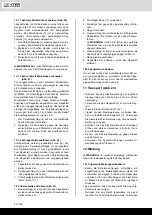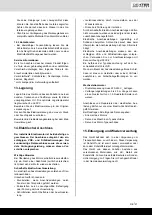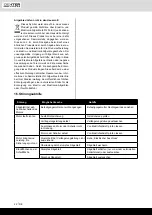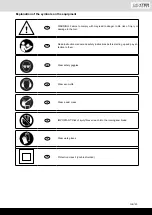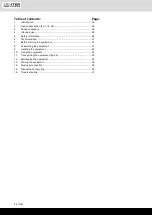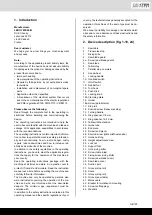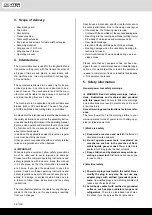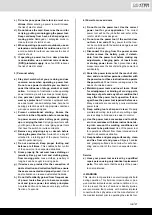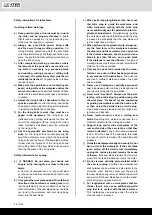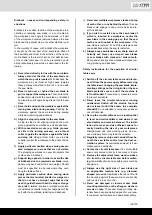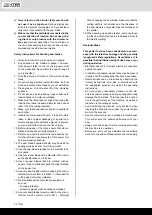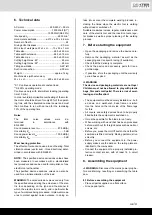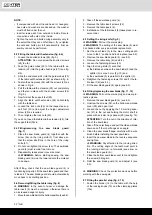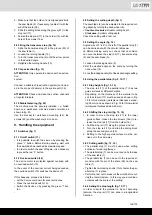
34 | GB
4. Guide at the side with your left or right hand (de-
pending on the position of the parallel stop) only
as far as the front edge of the saw blade guard (4).
5. Always push the workpiece through to the end of
the splitter (3).
6. The offcut piece remains on the saw table (1) until
the saw blade (5) is back in its position of rest.
7. Secure long workpieces against falling off at the
end of the cut (e.g. with a roller stand etc.).
ATTENTION:
The parallel stop must be set parallel
with the saw blade (see 8.7). Check the alignment and
ensure that the parallel stop is firmly seated at regular
intervals, particularly during use and after longer periods
not in use. Tighten the screw again and adjust the paral-
lel stop (see 9.4.3) if necessary. Vibrations can loosen
screws and change the position of the parallel stop.
10.1.1 Cutting narrow workpieces (fig. 20)
Be sure to use a push stick (14) when making longitu-
dinal cuts in workpieces smaller than 120 mm in width.
A push stick (14) is supplied with the saw! Replace a
worn or damaged push stick immediately.
1. Adjust the parallel stop (7) to the width of work-
piece you require (see 9.4).
2. Feed in the workpiece with two hands. Always use
the push stick (14) in the area of the saw blade.
3. Always push the workpiece through to the end of
the splitter (3).
m
WARNING:
With short workpieces, use the push
stick (14) from the beginning.
10.1.2
Cutting extremely narrow workpieces
(fig. 21)
Be sure to use a push block when making longitudi-
nal cuts in very narrow workpieces with a width of 30
mm and less. There is no push block supplied with the
saw! (Available from your specialist dealer) Replace
the push block without delay when it becomes worn.
When sawing workpieces, these can become jammed
between the parallel stop and the saw blade, be
caught by the saw blade, and be thrown from the ma-
chine. Therefore, the low guide face of the parallel
stop is best used in this case (see fig. 16). If required,
change over the stop rail (see 9.4.2).
1. Adjust the parallel stop to the width of workpiece
you require.
2. Use the push block to press the workpiece against
the stop rail and push the workpiece with the push
stick (14) through to the end of the splitter.
10.1.3 Making angular cuts (fig. 22)
Angular cuts must always be made using the parallel
stop (7). The parallel stop (7) must always be fitted
to the right of the saw blade. Otherwise, workpieces
can become jammed between the parallel stop and
the saw blade during sawing and ejected at speed.
Rule of thumb: The rear edge of the stop should inter-
sect an imaginary line that starts roughly at the centre
of the saw blade and runs to the rear at 45°:
1. Set the required cutting width.
2. Loosen the screws (16a) and slide the stop rail
(17) far enough forward that it touches the imagi-
nary 45° line.
3. Tighten the screws (16a) again.
9.5 Using the transverse stop (fig. 18)
When trimming, the transverse stop (2) must be ex-
tended from the parallel stop (7) with the stop rail (17)
(fig. 18).
9.5.1 Extending the transverse stop
1. Remove the stop rail (17) from the parallel stop
(7). To do so, loosen the screws (16a) and release
the stop rail (17) from the holder (16).
2. Slide the sliding block along the groove in the stop
rail (17).
3. Fasten the stop rail (17) with the help of the knurled
screws (18) on the transverse stop (2).
ATTENTION
Do not push the stop rail (17) too far toward to the saw
blade (5). The distance between the stop rail (17) and
the saw blade (5) should be approx. 2 cm.
10. Using the equipment
Working instructions
• After each new adjustment it is advisable to carry
out a trial cut in order to check the set dimensions.
• After switching on the saw, wait for the blade to
reach its maximum speed of rotation before com-
mencing with the cut.
• Take extra care when starting the cut.
• Never use the equipment without the suction func-
tion.
• Regularly check and clean the suction channels.
10.1 Making longitudinal cuts (fig. 19)
Longitudinal cutting is when you use the saw to cut
along the grain of the wood. One edge of the work-
piece will be pressed against the parallel stop (7),
while the flat side lies on the saw table (1).
The saw blade guard (4) must always be lowered over
the workpiece. When making a longitudinal cut, never
adopt a working position that is in line with the cutting
direction.
1. Set the parallel stop (7) in accordance with the
workpiece height and the desired width (see 9.4).
2. Switch on the saw.
3.
Place your hands (with fingers closed) flat on the
workpiece and push the workpiece along the par-
allel stop (7) and into the saw blade (5).
Содержание 3901309953
Страница 2: ...2 ...
Страница 4: ...4 10 6 6 7 9 8 8 14 11 4a 12 14 13 24 32 34 20 21 33 25 23 4 35 20 36 3 6 3 31 max 5mm ...
Страница 5: ...5 16 18 14 19 20 15 17 21 45 8 17 16a 37 9 16 17 16 17 18 19 40 39 16a 38 38 16a 17 ...
Страница 6: ...6 22 24 23 41 25 42 43 43 42 44 44 ...
Страница 70: ...70 ...
Страница 72: ...72 ...
Страница 76: ...LEROY MERLIN RUE Chanzy Lezennes 59712 LILLE Cedex 9 France ...

